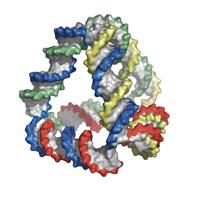DNA machines, living examples of nanotechnology

Produce with DNA a pH indicator and an engine that moves to the desired place
The Tata Institute for Basic Research in Bangalore, India, has developed an indicator to measure pH acidity between 7 and pH 5 using three DNA fragments. The three parts come together spontaneously, leaving one of their ends loose. At this end cysteine bases have been added. Usually cysteine is assimilated to guanine, but in acid medium cysteine binds to protons and binds. Consequently, the structure changes: the straight and open structure is transformed into a triangle.
Researchers have used fluorescent markers to visualize and interpret the appearance of the DNA indicator. Thus, in neutral medium (pH 7), when the DNA indicator is correct, the markers present green fluorescence, while in triangular form (pH 5) the markers interact and create red fluorescence. The colors between the two indicate intermediate pH.
These DNA indicators work in living systems, even within the cell. This is very useful as cell pH changes are related to diseases.
Another DNA application has been developed at the University of New York (USA). In fact, they have taken a step that until now they had not achieved: They have managed to move a DNA motor in the desired direction. For this they have made a path, also DNA, which serves to move the DNA motors in a certain direction. According to researchers, these DNA engines can be used to "bind complex molecules or to transport drugs and molecular machines in the body."
Buletina
Bidali zure helbide elektronikoa eta jaso asteroko buletina zure sarrera-ontzian











